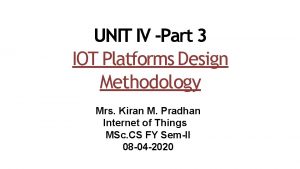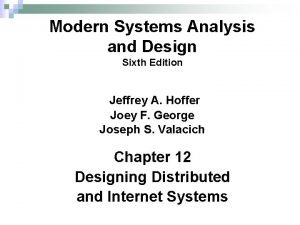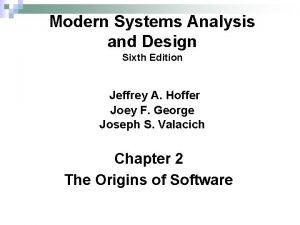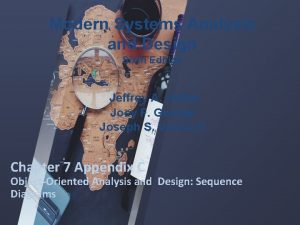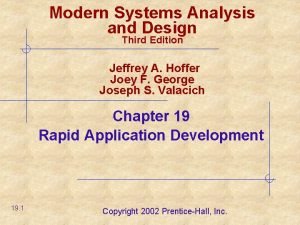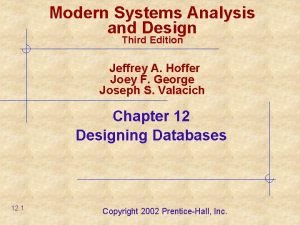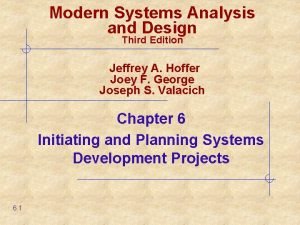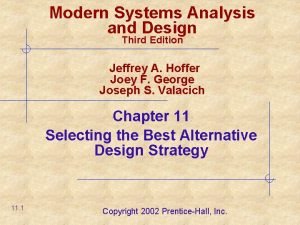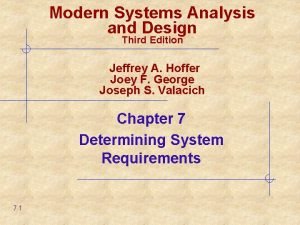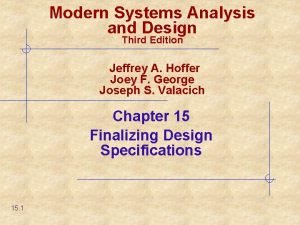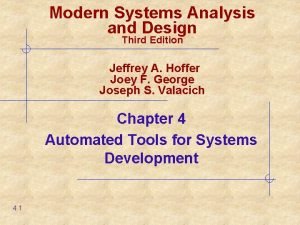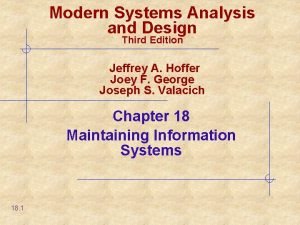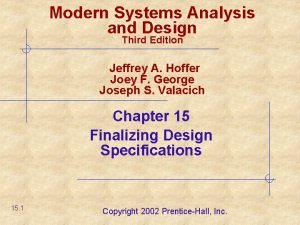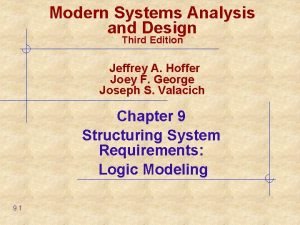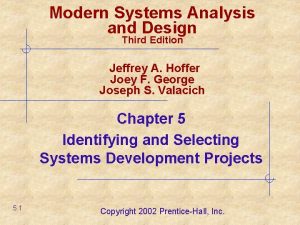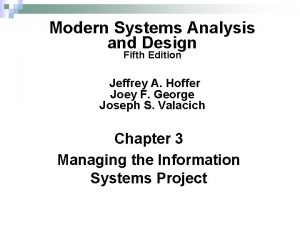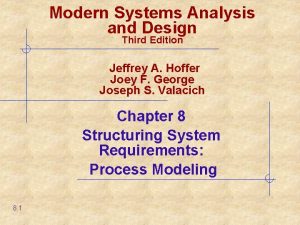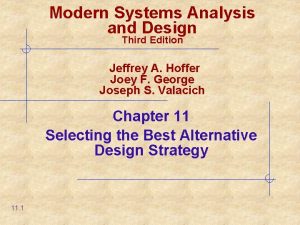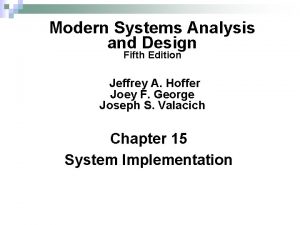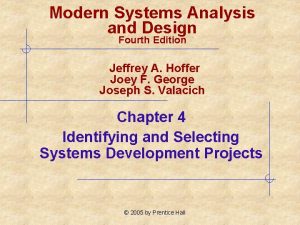Modern Systems Analysis and Design Sixth Edition Jeffrey







































- Slides: 39

Modern Systems Analysis and Design Sixth Edition Jeffrey A. Hoffer Joey F. George Joseph S. Valacich Chapter 1 The Systems Development Environment

Learning Objectives ü ü Define information systems analysis and design. Describe the information Systems Development Life Cycle (SDLC). Explain Rapid Application Development (RAD), prototyping, Computer Aided Software Engineering (CASE), and Service-Oriented Architecture (SOA). Describe agile methodologies and e. Xtreme programming. Chapter 1 Copyright © 2011 Pearson Education, Inc. Publishing as Prentice Hall 2

Introduction n Information Systems Analysis and Design ¨ Complex organizational process ¨ Used to develop and maintain computerbased information systems ¨ Used by a team of business and systems professionals Chapter 1 Copyright © 2011 Pearson Education, Inc. Publishing as Prentice Hall 3

Introduction (Cont. ) FIGURE 1 -1 An organizational approach to systems analysis and design is driven by methodologies, techniques, and tools Chapter 1 Copyright © 2011 Pearson Education, Inc. Publishing as Prentice Hall 4

A Modern Approach to Systems Analysis and Design 1950 s: focus on efficient automation of existing processes n 1960 s: advent of 3 GL, faster and more reliable computers n 1970 s: system development becomes more like an engineering discipline n Chapter 1 Copyright © 2011 Pearson Education, Inc. Publishing as Prentice Hall 5

A Modern Approach to Systems Analysis and Design (Cont. ) 1980 s: major breakthrough with 4 GL, CASE tools, object oriented methods n 1990 s: focus on system integration, GUI applications, client/server platforms, Internet n The new century: Web application development, wireless PDAs, componentbased applications n Chapter 1 Copyright © 2011 Pearson Education, Inc. Publishing as Prentice Hall 6

A Modern Approach to Systems Analysis and Design (Cont. ) n Application Software ¨ Computer software designed to support organizational functions or processes n Systems Analyst ¨ Organizational role most responsible for analysis and design of information systems Chapter 1 Copyright © 2011 Pearson Education, Inc. Publishing as Prentice Hall 7

The Good Analyst is … n n n 8 A problem-solver An excellent communicator An active listener A critical thinker Willing to make decisions and be held accountable An agent of change Willing to question assumptions Open-minded and flexible Willing to work to learn business-side issues Experienced with technology and programming Able to work in a team environment

Developing Information Systems n System Development Methodology is a standard process followed in an organization to conduct all the steps necessary to analyze, design, implement, and maintain information systems. Chapter 1 Copyright © 2011 Pearson Education, Inc. Publishing as Prentice Hall 9

Systems Development Life Cycle (SDLC) n n Traditional methodology used to develop, maintain, and replace information systems. Phases in SDLC: ¨ Planning ¨ Analysis ¨ Design ¨ Implementation ¨ Maintenance Chapter 1 Copyright © 2011 Pearson Education, Inc. Publishing as Prentice Hall 10

Standard and Evolutionary Views of SDLC FIGURE 1 -2 The systems development life cycle Chapter 1 FIGURE 1 -3 Evolutionary model Copyright © 2011 Pearson Education, Inc. Publishing as Prentice Hall 11

Systems Development Life Cycle (SDLC) (Cont. ) Planning – an organization’s total information system needs are identified, analyzed, prioritized, and arranged n Analysis – system requirements are studied and structured n Chapter 1 Copyright © 2011 Pearson Education, Inc. Publishing as Prentice Hall 12

Systems Development Life Cycle (SDLC) (Cont. ) Design – a description of the recommended solution is converted into logical and then physical system specifications n Logical design – all functional features of the system chosen for development in analysis are described independently of any computer platform n Chapter 1 Copyright © 2011 Pearson Education, Inc. Publishing as Prentice Hall 13

Systems Development Life Cycle (SDLC) (Cont. ) n Physical design – the logical specifications of the system from logical design are transformed into the technology -specific details from which all programming and system construction can be accomplished Chapter 1 Copyright © 2011 Pearson Education, Inc. Publishing as Prentice Hall 14

Systems Development Life Cycle (SDLC) (Cont. ) Implementation – the information system is coded, tested, installed and supported in the organization n Maintenance – an information system is systematically repaired and improved n Chapter 1 Copyright © 2011 Pearson Education, Inc. Publishing as Prentice Hall 15

Chapter 1 Copyright © 2011 Pearson Education, Inc. Publishing as Prentice Hall 16

The Heart of the Systems Development Process FIGURE 1 -7 The analysis–design–code–test loop FIGURE 1 -8 The heart of systems development Current practice combines analysis, design, and implementation into a single iterative and parallel process of activities. Chapter 1 Copyright © 2011 Pearson Education, Inc. Publishing as Prentice Hall

Traditional Waterfall SDLC See http: //www. learn. geekinterview. com/it/sdlcmethodology-steps. html One phase begins when another completes, with little backtracking and looping. FIGURE 1 -9 A traditional waterfall SDLC Chapter 1 Copyright © 2011 Pearson Education, Inc. Publishing as Prentice Hall 18

Problems with Waterfall Approach System requirements “locked in” after being determined (can't change) n Limited user involvement (only in requirements phase) n Too much focus on milestone deadlines of SDLC phases to the detriment of sound development practices n Can be very time consuming and expensive n Chapter 1 Copyright © 2011 Pearson Education, Inc. Publishing as Prentice Hall 19

Different Approaches to Improving Development n CASE Tools n Rapid Application Development (RAD) n Agile Methodologies n e. Xtreme Programming Chapter 1 Copyright © 2011 Pearson Education, Inc. Publishing as Prentice Hall 20

Computer-Aided Software Engineering (CASE) Tools Diagramming tools enable graphical representation. n Computer displays and report generators help prototype how systems “look and feel”. n Chapter 1 Copyright © 2011 Pearson Education, Inc. Publishing as Prentice Hall 21

Computer-Aided Software Engineering (CASE) Tools (Cont. ) Analysis tools automatically check for consistency in diagrams, forms, and reports. n A central repository provides integrated storage of diagrams, reports, and project management specifications. n Chapter 1 Copyright © 2011 Pearson Education, Inc. Publishing as Prentice Hall 22

Computer-Aided Software Engineering (CASE) Tools (Cont. ) Documentation generators standardize technical and user documentation. n Code generators enable automatic generation of programs and database code directly from design documents, diagrams, forms, and reports. n Chapter 1 Copyright © 2011 Pearson Education, Inc. Publishing as Prentice Hall 23

CASE Tools (Cont. ) FIGURE 1 -10 A class diagram from IBM’s Rational Rose (Source: IBM) Chapter 1 Copyright © 2011 Pearson Education, Inc. Publishing as Prentice Hall 24

CASE Tools (Cont. ) VIDEO: Corporate Modeler VIDEO: Overview of CASE tools Chapter 1 Copyright © 2011 Pearson Education, Inc. Publishing as Prentice Hall 25

Rapid Application Development (RAD) n Methodology to radically decrease design and implementation time n Involves: extensive user involvement, prototyping, JAD sessions, integrated CASE tools, and code generators Chapter 1 Copyright © 2011 Pearson Education, Inc. Publishing as Prentice Hall 26

Rapid Application Development (RAD) (Cont. ) FIGURE 1 -11 RAD life cycle Chapter 1 Copyright © 2011 Pearson Education, Inc. Publishing as Prentice Hall 27

Service-Oriented Architecture (SOA) n An approach to systems development based on building complete systems through assembling software components, each of which model generic business functions Chapter 1 Copyright © 2011 Pearson Education, Inc. Publishing as Prentice Hall 28

Service-Oriented Architecture (SOA) (Cont. ) FIGURE 1 -12 Illustration of a service, a credit check, used by applications and other services Chapter 1 Copyright © 2011 Pearson Education, Inc. Publishing as Prentice Hall 29

Agile Methodologies Motivated by recognition of software development as fluid, unpredictable, and dynamic n Three key principles n ¨ Adaptive rather than predictive ¨ Emphasize people rather than roles ¨ Self-adaptive processes Chapter 1 Copyright © 2011 Pearson Education, Inc. Publishing as Prentice Hall 30

The Agile Methodologies group argues that software development methodologies adapted from engineering generally do not fit with realworld software development. Chapter 1 Copyright © 2011 Pearson Education, Inc. Publishing as Prentice Hall 31

When to use Agile Methodologies n If your project involves: ¨ Unpredictable or dynamic requirements ¨ Responsible and motivated developers ¨ Customers who understand the process and will get involved Chapter 1 Copyright © 2011 Pearson Education, Inc. Publishing as Prentice Hall 32

Chapter 1 Copyright © 2011 Pearson Education, Inc. Publishing as Prentice Hall 33

e. Xtreme Programming Short, incremental development cycles n Automated tests n Two-person programming teams n Chapter 1 Copyright © 2011 Pearson Education, Inc. Publishing as Prentice Hall 34

e. Xtreme Programming (Cont. ) Coding and testing operate together n Advantages: n ¨ Communication between developers ¨ High level of productivity ¨ High-quality code Chapter 1 Copyright © 2011 Pearson Education, Inc. Publishing as Prentice Hall 35

Object-Oriented Analysis and Design (OOAD) n Based on objects rather than data or processes n Object: a structure encapsulating attributes and behaviors of a realworld entity Chapter 1 Copyright © 2011 Pearson Education, Inc. Publishing as Prentice Hall 36

Object-Oriented Analysis and Design (OOAD) (Cont. ) n Object class: a logical grouping of objects sharing the same attributes and behaviors n Inheritance: hierarchical arrangement of classes enable subclasses to inherit properties of superclasses Chapter 1 Copyright © 2011 Pearson Education, Inc. Publishing as Prentice Hall 37

Our Approach to Systems Development The SDLC is an organizing and guiding principle in this book. n We may construct artificial boundaries or artificially separate activities and processes for learning purposes. n Our intent is to help you understand all the pieces and how to assemble them. n Chapter 1 Copyright © 2011 Pearson Education, Inc. Publishing as Prentice Hall 38

Summary n In this chapter you learned how to: ü Define information systems analysis and design. Describe the information Systems Development Life Cycle (SDLC). Explain Rapid Application Development (RAD), prototyping, Computer Aided Software Engineering (CASE), and Service-Oriented Architecture (SOA). Describe agile methodologies and e. Xtreme programming. ü ü ü Chapter 1 Copyright © 2011 Pearson Education, Inc. Publishing as Prentice Hall 39
 Modern systems analysis and design 7th edition
Modern systems analysis and design 7th edition Peter piper picked
Peter piper picked Rubber baby buggy bumpers tongue twister lyrics
Rubber baby buggy bumpers tongue twister lyrics Case tools are limited to systems analysis.
Case tools are limited to systems analysis. Modern systems analysis and design
Modern systems analysis and design A modern approach to systems analysis and design
A modern approach to systems analysis and design Biochemistry sixth edition
Biochemistry sixth edition Modern operating systems 3rd edition
Modern operating systems 3rd edition Modern operating systems tanenbaum 5th edition
Modern operating systems tanenbaum 5th edition Computer architecture a quantitative approach sixth edition
Computer architecture a quantitative approach sixth edition Automotive technology sixth edition
Automotive technology sixth edition Automotive technology sixth edition
Automotive technology sixth edition Apa sixth edition
Apa sixth edition Computer architecture a quantitative approach sixth edition
Computer architecture a quantitative approach sixth edition Precalculus sixth edition
Precalculus sixth edition Principles of economics sixth edition
Principles of economics sixth edition Computer architecture a quantitative approach sixth edition
Computer architecture a quantitative approach sixth edition Systems analysis and design kendall
Systems analysis and design kendall Iot design methodolgy is to define the
Iot design methodolgy is to define the Hamlet soliloquy 6
Hamlet soliloquy 6 Using mis (10th edition) 10th edition
Using mis (10th edition) 10th edition Report
Report Systems analysis and design in an age of options pdf
Systems analysis and design in an age of options pdf System analysis and design
System analysis and design Systems analysis and design in a changing world
Systems analysis and design in a changing world System analysis and design in a changing world
System analysis and design in a changing world Systems analysis and design dennis
Systems analysis and design dennis System analysis and design
System analysis and design What is ssadm methodology
What is ssadm methodology Kendall & kendall systems analysis and design
Kendall & kendall systems analysis and design Alan dennis system analysis design
Alan dennis system analysis design Systems analysis and design alan dennis
Systems analysis and design alan dennis Systems analysis and design alan dennis
Systems analysis and design alan dennis Systems analysis and design alan dennis
Systems analysis and design alan dennis Systems analysis and design alan dennis
Systems analysis and design alan dennis Systems analysis and design alan dennis
Systems analysis and design alan dennis Systems analysis and design alan dennis
Systems analysis and design alan dennis Ssadm diagram
Ssadm diagram Radar systems analysis and design using matlab
Radar systems analysis and design using matlab Object-oriented systems analysis and design using uml
Object-oriented systems analysis and design using uml


















